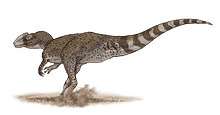Chuandongocoelurus
Chuandongocoelurus (/tʃwɑːnˌdɒŋəsɪˈljʊərəs/ chwahn-DONG-ə-si-LEWR-əs) is a genus of carnivorous tetanuran theropod dinosaur from the Jurassic of China.
| Chuandongocoelurus | |
|---|---|
 | |
| Skeletal diagram showing known remains | |
| Scientific classification | |
| Kingdom: | Animalia |
| Phylum: | Chordata |
| Clade: | Dinosauria |
| Clade: | Saurischia |
| Clade: | Theropoda |
| Genus: | †Chuandongocoelurus He, 1984 |
| Species: | †C. primitivus |
| Binomial name | |
| †Chuandongocoelurus primitivus He, 1984 | |
Discovery and naming

The type species Chuandongocoelurus primitivus was first described and named by Chinese paleontologist He Xinlu in 1984. The generic name combines references to the Chuandong in Sichuan Province and the theropod genus Coelurus, itself named after the Greek κοῖλος, koilos, meaning "hollow" and οὐρά, oura, meaning "tail". The specific name means "the primitive one" in Latin, a reference to the great age of the find.[1]
He assigned two partial skeletons to Chuandongocoelurus. The holotype, a thighbone, is part of specimen CCG 20010. Vertebrae, pelvic bones and hindlimb elements, also catalogued under this inventory number, may belong to the same individual. The specimen has unfused neurocentral sutures in its vertebrae, meaning that the animal was immature at the time of death. The formation in which it was discovered was the Lower Shaximiao Formation, meaning Chuandongocoelurus dates to the Bathonian or Callovian stage of the Middle Jurassic. The second specimen, CCG 20011, is a set of neck vertebrae from a much larger individual.[1] In 2012, it was concluded that both specimens represent different taxa, probably not even closely related. CCG 20011 was found to instead share similarities with the ceratosaur Elaphrosaurus[2]
The holotype thighbone has a length of 201 millimetres.[1]
Classification

He placed Chuandongocoelurus in the Coeluridae,[1] at the time a wastebasket taxon including almost all small theropods. David Bruce Norman in 1990 considered it to be an indeterminate theropod.[3] More recently, Roger Benson (2008, 2010) and Benson et al. (2010) found it to be the sister taxon of Monolophosaurus, together forming a clade belonging either to Megalosauroidea[4][5] or outside of Megalosauroidea in the Tetanurae.[6] In 2012, Matthew Carrano et al. found Chuandongocoelurus outside of the Megalosauroidea.[2]
The cladogram below follows Rauhut and Pol (2019):[7]
| Averostra |
| ||||||||||||||||||||||||||||||||||||||||||||||||||||||||||||||||||
References
- He, 1984. The vertebrate fossils of Sichuan. Sichuan Scientific and Technological Publishing House. 168 pp.
- M.T. Carrano, R.B.J. Benson, and S.D. Sampson, 2012, "The phylogeny of Tetanurae (Dinosauria: Theropoda)", Journal of Systematic Palaeontology 10(2): 211-300
- Norman, David B. (1990). Problematic Theropoda: "Coelurosaurs". p. 280-305 in David B. Weishampel, et al. (eds.), The Dinosauria. University of California Press, Berkeley, Los Angeles, Oxford.
- Benson, 2008. A new theropod phylogeny focussing on basal tetanurans, and its implications for European 'megalosaurs' and Middle Jurassic dinosaur endemism. Journal of Vertebrate Paleontology. 51A
- Benson, R.B.J. (2010). "A description of Megalosaurus bucklandii (Dinosauria: Theropoda) from the Bathonian of the UK and the relationships of Middle Jurassic theropods". Zoological Journal of the Linnean Society. 158 (4): 882–935. doi:10.1111/j.1096-3642.2009.00569.x.
- Benson, Brusatte and Carrano, 2010. A new clade of large-bodied predatory dinosaurs (Theropoda: Allosauroidea) that survived to the latest Mesozoic. Naturwissenschaften. 97, 71-78
- Rauhut, Oliver W. M.; Pol, Diego (2019-12-11). "Probable basal allosauroid from the early Middle Jurassic Cañadón Asfalto Formation of Argentina highlights phylogenetic uncertainty in tetanuran theropod dinosaurs". Scientific Reports. 9 (1): 18826. doi:10.1038/s41598-019-53672-7. ISSN 2045-2322. PMC 6906444. PMID 31827108.
External links
_(Antwerpener_Breiftaube).jpg)
.jpg)

















